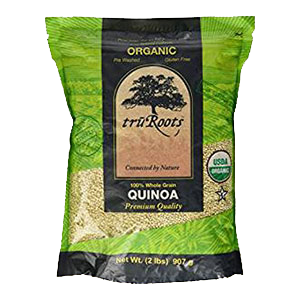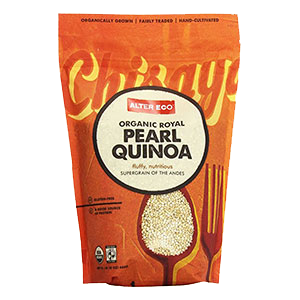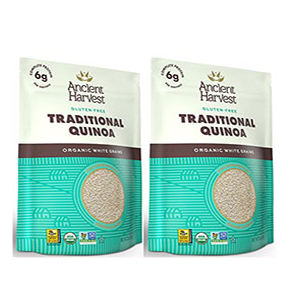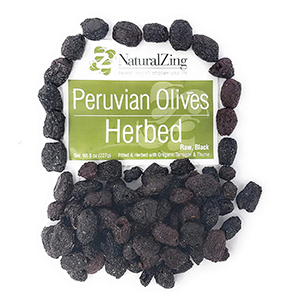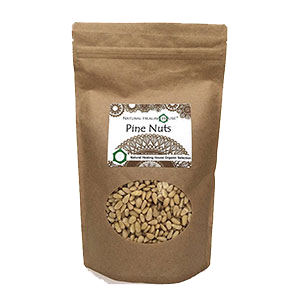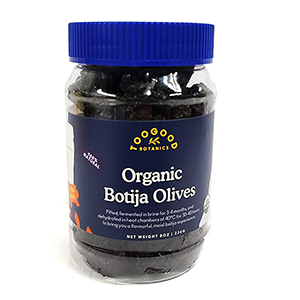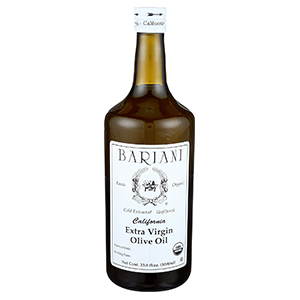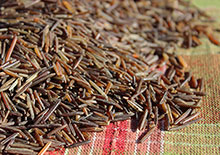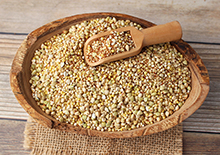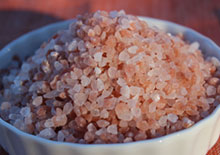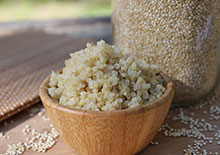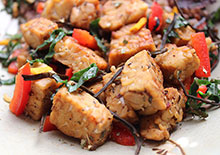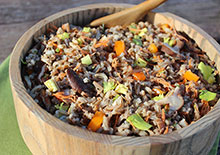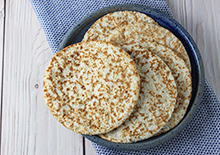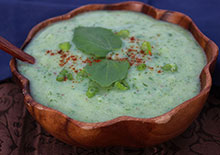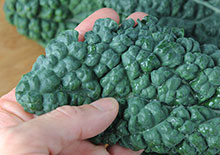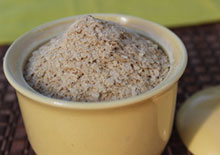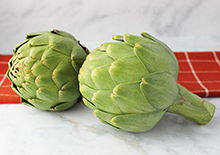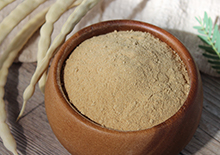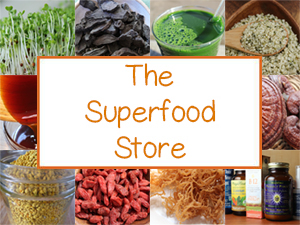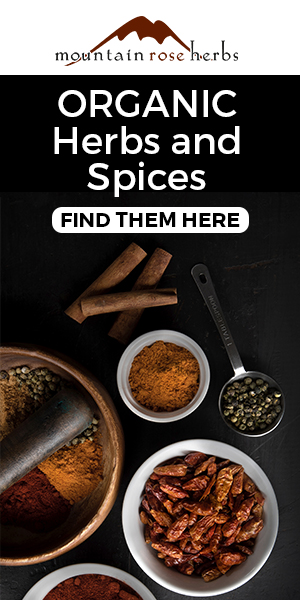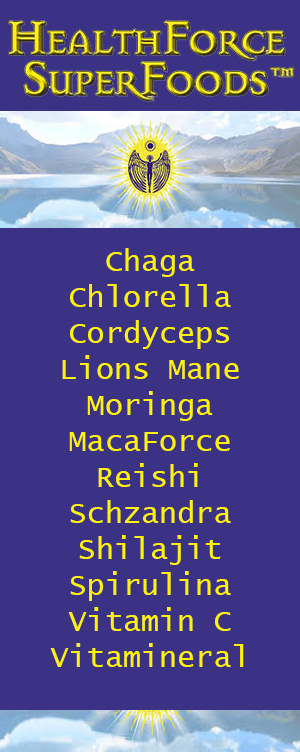- Home
- Plant-Based Cooking
- Quinoa Salad Recipe
Quinoa Salad Recipe, A Mediterranean Version
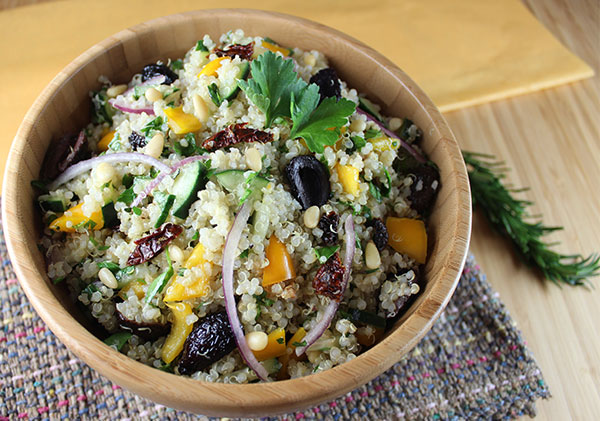
This quinoa salad recipe is a personal favorite utilizing one of our top cooked grains of choice, quinoa.
Pronounced "keen-wah", this South American staple makes an especially nice salad ingredient when cooked, cooled and added to chopped, diced and thinly sliced raw vegetables and a marinade using fresh herbs.
We then fold into the mix two rich and tasty fats: pine nuts and sun-dried black botija olives.
Very similar to the popular "quinoa tabbouleh", but with a Mediterranean twist, a quinoa recipe like this one is a great choice for a light and refreshing main meal or can likewise be served as a side dish to other protein sources.
Don't forget, as far as grains go, quinoa is a little higher in protein content and can be an especially preferred option for those following a vegan or vegetarian diet.
Compared to other grains, it also offers a higher protein to lower carbohydrate ratio as well as a balanced essential amino acid profile, making it a complete protein source.
What is Quinoa?
Most likely if you have arrived on this quinoa salad recipe page, you know a little bit about this alternative grain (Chenopodium quinoa) indigenous to the Andean regions of Bolivia and Peru, particularly the Lake Titicaca region bordering these two countries.
Dry quinoa seeds have a flat rounded shape and when cooked have a comparable texture to that of couscous or bulgur wheat. When completely steamed in water, the seeds pop open to form tiny rounded balls with a white curled germ falling off of them.
We first started eating quinoa over 25 years ago, when it was considerably less popular than it is today. It has over the years become one of our regular vegan cooked food staples that we consume more than any other whole grain variety.
Largely popularized in the mid 1990's by Donna Gates and her book The Body Ecology Diet, it was promoted as a more alkalinizing "BED grain" to consume for those with candida overgrowth.
Alkaline-forming foods are believed to help counteract blood acidity and balance body pH which can be helpful for establishing a healthy equilibrium of intestinal bacteria in the body, especially the colon.
Quinoa provides a better alternative to other common staples, like corn, rice, oats, wheat and animal-derived sources, which all tend to be acid-forming in the body after consumption.
Along with other gluten-free options, like buckwheat, teff, millet and amaranth, it is lighter, less mucous forming and usually easier to digest for those with allergic sensitivities to gluten.
In a study analyzing the gastrointestinal effects of eating quinoa it was identified that the "Addition of quinoa to the GFD [gluten-free diet] of celiac patients was well tolerated and did not exacerbate the condition."
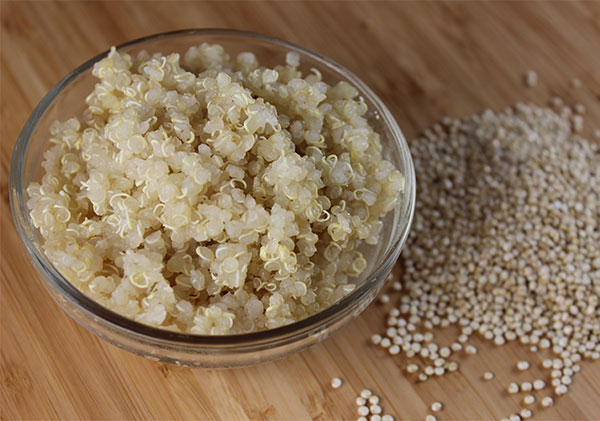
What Does It Taste Like?
When it is properly prepared it has a light and fluffy texture with a distinct nutty quinoa flavor.
If
you're looking for a pasta replacement, quinoa might provide a nice substitute. Although the shape and texture is nothing like
noodles or spaghetti, as a high protein food, it does have a rich
dense pasta-like quality.
For some people, the texture might take
a little getting used as it does not have a chewy starchy consistency
like rice or glutenous grains.
A slightly bitter taste can sometimes be detected, as the seeds are known to contain a natural saponin coating, which can act as an "antinutrient", causing mild digestive upset for some individuals.
List of top organic suppliers and their saponin removal procedure.
This can be reduced by soaking or pre-rinsing the grains before cooking them. This process is also beneficial for lessening any phytates that may be present on the dry seeds.
These days, however, most commercially produced quinoa is pre-washed to remove most of the saponin content to make it more flavorful and to increase its assimilation. Some suppliers also provide dry whole grains that have been pre-soaked and pre-sprouted.
Quinoa Nutrition
The year 2013 was officially declared by The Food and Agriculture Organization of the United Nations as the "International Year of Quinoa" in recognition of the native Andean peoples, but also to honor quinoa's "exceptional nutritional properties." (*)
As we mentioned, quinoa is slightly higher in protein content than other whole grain types. By comparison, it also has a higher protein to lower carbohydrate ratio. (*)
Protein Vs. Carbohydrate Ratios
(One Cup/Cooked)
8g protein ..............................Quinoa............................. 39g carb
5g protein ............... Brown Rice, Long Grain................ 45g carb
4g protein ............... White Rice, Long Grain............... 45g carb
Quinoa is also considered a complete protein, as it contains all essential amino acids. It is particularly higher in the essential amino acid lysine, which is typically lower in most grains.
Consumed as a cooked whole food, it comprises a number of vitamins and minerals such as magnesium and iron as well as B vitamins like riboflavin, thiamin, B6 and folate. It also provides slightly more calcium, potassium and zinc in contrast to other staple grains.
Whole grains, like quinoa, are valuable source of dietary fiber which help to facilitate digestion and ensure bowel regularity.
(For more about quinoa nutrition visit our health benefits of quinoa page.)
How to Cook Quinoa
Quinoa is not only one of our healthiest go-to whole grain staples, but also one that's incredibly easy and quick to cook up for a last minute meal.
As a fast-cooking grain, it usually only requires about 20-30 minutes total cooking time, depending on how much water you add.
It is a good idea to rinse it briefly before use to remove any residual saponin content and occasional dirt clods or rocks that, we have noticed, sometimes find their way into the bulk grains.
Some people, in addition to rinsing, also soak it for a short period of time to reduce phytates, in which case you would use about 1/2C less water.
While most cooked quinoa recipes call for 1C dry quinoa to 2C water, this in our opinion only partially cooks it and can leave some undesirable crunchiness.
We prefer the texture and digestibility of quinoa that is made with 1C quinoa to at least 2 1/2C water. This grain:water ratio produces a light and fluffy consistency as opposed to an under-cooked quality that can also be hard to digest.
However, this is a matter of personal preference, so you may need to experiment.
(For more information on how to cook quinoa, please visit our quinoa recipe page.)
Our Basic Quinoa Recipe
Ingredients:
- 1C quinoa grain
- 2 1/2C pure water
- 1/8t pink salt or celtic sea salt
Directions:
- Briefly submerge and rinse the quinoa in pure filtered water.
- Thoroughly strain out the water and add to a glass or ceramic pot with 2 1/2C water and salt.
- Bring to a boil and simmer on the lowest flame setting undisturbed with lid on for 20-25 minutes, or until no liquid is present when you tilt the pot.
- Turn the flame off and let the quinoa sit with lid on for another 5-10 minutes.
- This recipe will make 5 cups of cooked quinoa.
Mediterranean Quinoa Salad Recipe
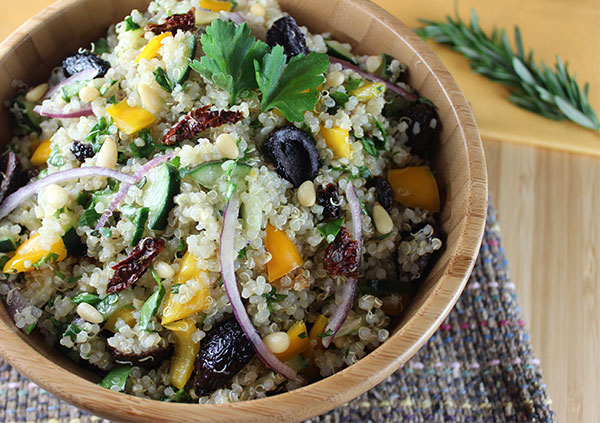
This quinoa salad recipe is a great way to liven-up your cooked quinoa with fresh raw enzyme-rich vegetables and provides a very appetite satisfying salad filled with savory taste sensations.
The cooled cooked quinoa can be mixed with the ingredients and dressing marinade right before serving or it can be prepared in advance. It fills a medium salad bowl, usually yielding about 4-6 serving size portions.
We use black botija sun-dried olives because of their exquisite taste, but you can use other types of olives if you prefer. We recommend those that are ripe, unpasteurized and prepared in natural brine solutions as oppose to those softened with chemicals such as lye or artificially darkened with ferrous gluconate.
Ingredients:
- 5C cooked quinoa
- 1C chopped cucumber
- 1C chopped yellow bell pepper
- 3/4C minced parsley
- 1/2C halved black olives
- 1/2C thinly sliced red onion
- 1/4C sun-dried tomatoes
- 1/4C minced basil
- 1/4C pine nuts
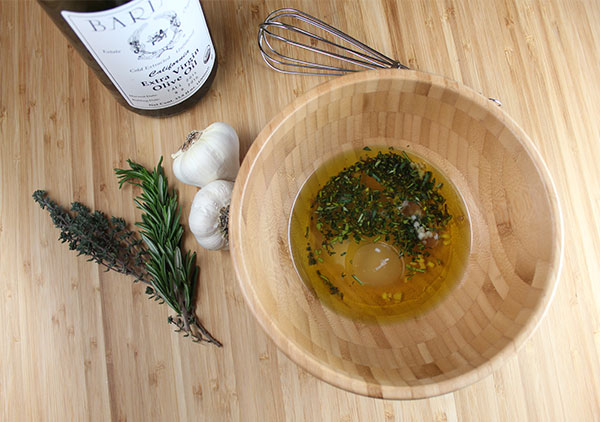
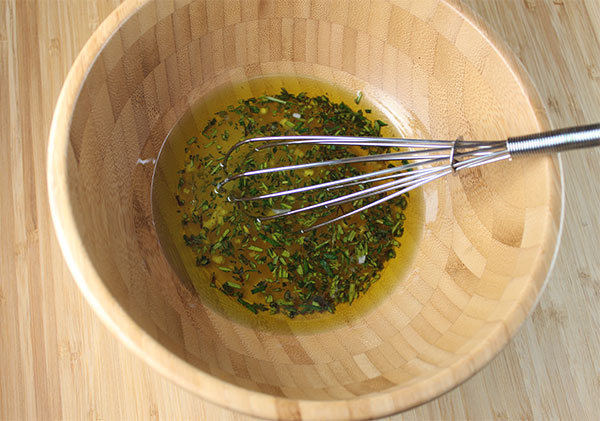
How to Make the Salad Dressing
- 1/4C apple cider vinegar
- 2T raw honey
- 2 cloves pressed garlic
- 1/2C olive oil
- 2T fresh minced herbs (rosemary, thyme and oregano)
- 1/8t pink salt
Whisk all of the ingredients together in a mixing bowl.
Directions:
- Add your cooled cooked quinoa to a large bowl.
- Mix in all ingredients and lastly fold in the dressing.
- Allow to marinate for approximately 20 minutes before serving.
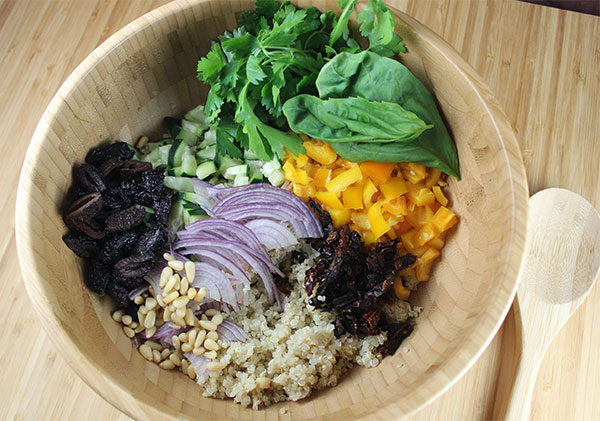
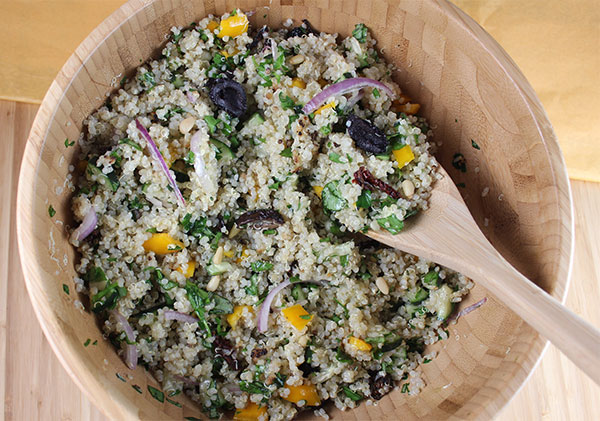
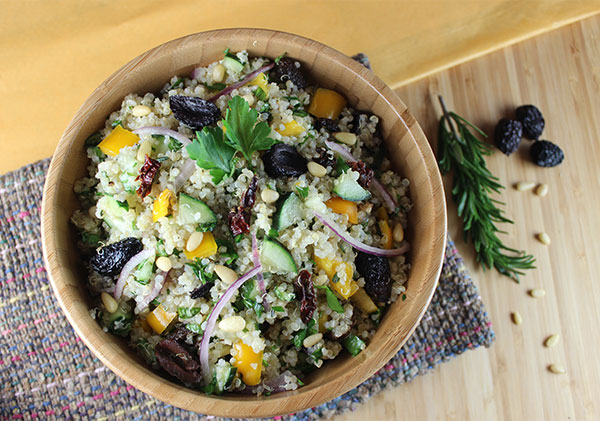
This is a quinoa salad recipe to enjoy fresh or can be made ahead of time for a potluck or family gathering. It makes an especially perfect summer-time meal.
Precautions:
Quinoa is considered a safe staple grain to consume on a regular basis. In rare cases, however, some individuals are sensitive to saponin residues that may be present the uncooked seeds, which can cause mild digestive upset. This effect is usually avoided by soaking and rinsing techniques as well as by thoroughly cooking the grain before consumption.
Shop Related Products (About Affiliates & Amazon Associate Paid Links)
Affiliate Disclaimer: This section contains affiliate product links. If you make a purchase through our recommended links, we receive a small commission at no additional cost to you. Thanks for the support.
